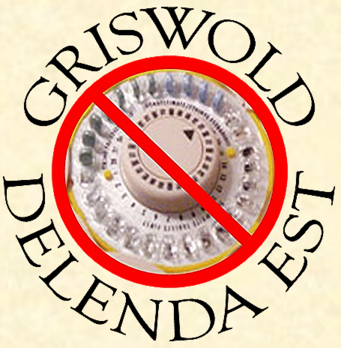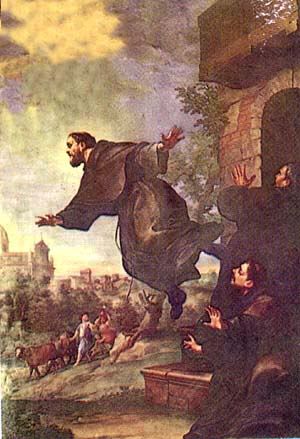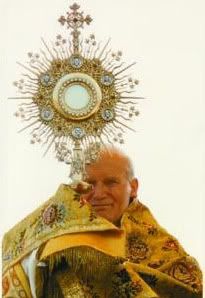Some Thoughts
Several of the members of the leadership committee for our John Cardinal Newman Community here at OWU went to Rome over Spring Break with our chaplain, and together they decided while there that there was no good reason for them not to kneel during the consecration at the semiweekly Mass held on campus. There are no kneelers in the room where the Mass is celebrated, but honestly folks, a little wood floor never killed anyone. So, last week for Palm Sunday, following the Sanctus, Father said "now we're going to kneel." And some folks got upset, because they liked the "laid back feel" of campus Mass, and thought that kneeling did something to that (this is why I don't go to Mass held on campus if I can at all help it). Then other people among the leadership, some of whom had flak over the kneeling directed at them, complained that they hadn't been consulted in the decision, as if this were some blasted congregationalist church. (If you want a vote in what happens, go be a Baptist.) They insisted on having a "discussion." Discussions tend to tick me off. As such, I "discussed" at some length at the rest of the leadership in an email, more or less reproduced below.
Some thoughts I didn't add in the email: The 70s are over. If you miss them so badly that you can't kneel for the consecration, go be an Episcopaleon or find yourself someplace like that St. Joan of Arc in Minesotta (or wherever that circus is). Also, the Jansenyst in me thinks that we shouldn't go so far out of our way to keep the people who only come to campus Mass in the pews -- uh, chairs. We only have Mass on campus every other week -- if they're not going to Mass in between, they probably shouldn't be coming and receiving when it's on campus (I mentioned this at the meeting today and was told "not to judge," whatever that means in this context).
My other thoughts, replete with document references:
The GIRM Sec. 42 par. 1 calls for the observations of "the traditional practices of the Roman rite." The organic tradition of the Roman rite that has been passed down by the Church and that we have received is to revere and adore the Blessed Sacrament by kneeling at the consecration. That's simple enough.
The exhortation to perform the sacred liturgy with an eye "what serves the common spiritual good of the People of God, rather than private inclination or arbitrary choice" seems to make the current situation more ambiguous. If the implementation of a worthy pious observance alienates certain members of the community from the sacred liturgy, does the good of the reverential act outweigh the unintended evil of the ill will that those persons have, as a result, chosen to direct towards the community, Fr. Dave, the Church, or whomever? Does this rubric require that the sacred liturgy be performed in a manner that "makes everyone happy"? At the very least, does it require that we take extraordinary steps to secure the presence of as many people as possible at the Mass, even if doing so requires action that runs contrary to the liturgical texts and the celebrant's interpretation of what they necessitate in his situation? Is it truly serving the "common spiritual good of the People of God" to permit and encourage, by our own willful actions, certain persons to acquire and sustain a perception of the Mass not in conformity with the tradition of the Church; to maintain such a strong preference for that flawed perception that they would absent themselves from the Mass and the Sacraments rather than assist at the Mass when said otherwise; and to have such a hardness of heart towards our Lord in the Blessed Sacrament that the act of kneeling before Him is categorically repugnant to them?
Do we really serve their spiritual good by continuing a practice that encourages such error? Or is to refrain from praiseworthy change for fear of their displeasure permitting the sacred liturgy to conform to "private inclination" and "arbitrary choice"? It seems evident that the latter is the case, and that the duty to serve the common spiritual good of the People of God requires that our actions as a de facto apostolate on this campus, especially in the provision of the Holy Mass, require that we conduct ourselves in a manner that encourages those around us to come to a fuller, truer, and richer understanding of and love for God, His Church, and especially His presence in the Sacrament of the Altar. The Church has, since the time of Christ, firmly understood that our actions shape our perceptions, and that our perceptions shape our beliefs. That is why we have always acted with all possible reverence towards the Blessed Sacrament. It would seem that any licit act, especially any habitual and authoritatively encouraged act, that encourages increased reverence for the Blessed Sacrament, should be embraced and adopted, for it is in these actions that the roots of faith are nourished in the human mind.
Sec. 43 par. 3 of the GIRM appears to have been translated poorly. It SAYS that conditional circumstances may permit standing between the Sanctus and the Great Amen, but that only episcopal dispensation may permit congregations to refrain from kneeling following the Agnus Dei. Given the examples it cites for circumstances that permit standing in the first case, however, it seems unlikely that it was intended to exclude this part of the Mass from the previous provision. This oddity does not appear to be present in the Latin (available here), which appears (my latin is not very good) to call for kneeling except where there is a "valid cause" such as "large numbers" or other "rational impediment." The final sentence dealing with the Agnus Dei is, in fact, a USCCB adaptation not present in the Latin original. So we may, I would imagine, disregard ICEL's inability to communicate effectively in the English language as mere oversight.
That said, does this language require us, in our locale in the smoker, to kneel? Sec. 43 par. 3 says "when prevented on occasion." The words "on occasion" were added by the USCCB, and act as a limiting device. Their addition, by specifying that the refraining from kneeling should be occasional -- and therefore situational -- implies that it should not be viewed as a habitual and desirable state of affairs. The words were likely added because many parishes in parts of the United States have in recent years viewed kneeling as a completely unnecessary act and have not taken steps to make accommodations for kneeling.
The Bishop's Conference wants us to know that we should be kneeling, and that we are dispensed in the case of an unusual occurrence. None of the examples listed (health, space, and numbers), indicate a permanent state of affairs. Notice that "the unsuitability of the environment" or "discomfort" are not among the reasons. Rather, the examples, which should inform one's interpretation of the point they illustrate because they represent the primary situations envisioned by the writers as well as the nature of the problem the provision seeks to solve, all point to temporary situations that come about due to the interaction of the qualities of the sanctuary and the congregation on that particular occasion. The use of a permanent quality of the building (such as the mere lack of kneelers) as justification for applying the exceptions of Sec. 43 par. 3 represents exceedingly poor exegesis, for it makes an appeal by way of analogy in a case where the two examples (no kneelers vs. too many people came) are inherently not analogous. The USCCB is most definitely aware that the Mass is celebrated at times in places without kneelers. Had they desired to make this a categorical exemption, they were perfectly free to include it, or at least an analogous situation, as such. As it is, they declined to do so, and we must read the document in light of that silence.
Chapter 4 of the GIRM reinforces the point that kneeling and genuflection are the appropriate and preferred acts of reverence towards the Blessed Sacrament, and that bowing is more properly reserved as an act, by the laity, of reverence for the Holy Name.
From Sec. 48 of Sacrosanctum Concilium, the words "[the faithful] should learn also to offer themselves [in the context of the Mass]" seemed to me to speak to the current discussion most directly. What is the act of kneeling? It is an offering of ourselves, a sign of supplication and reverence, in which we acknowledge our own inadequacy before God and implore His aid, here through His most wondrous Sacrament. It can, at times, be uncomfortable, but here too it is an offering of ourselves, for we are called to offer our sufferings, to unite them, as fully as possible, with those of Christ, for the propitiation of our sins and the glory of God. As the Mass is our participation in the perfect propitiation of Christ, it is only fitting that we should there offer our actions and our sufferings, those we endure throughout life and the minuscule inconvenience of kneeling.
Authorities Cited:
GIRM Chapter II (see Sec. 42-43)
GIRM Chapter IV (see Sec. 274-275)
Sacrosanctum Concilium (See sec. 48)
File Under: The_Liturgy








0 Comments:
Post a Comment
<< Home